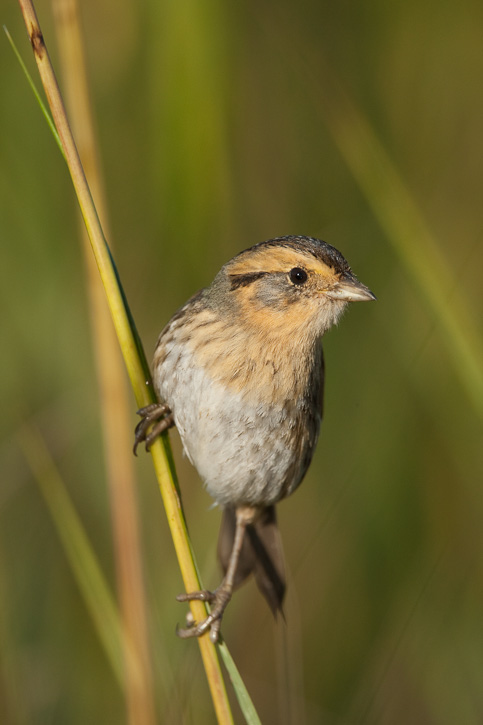
Ammodramus nelsoni
TAXONOMY
Ammodramus caudacutus var. nelsoni Allen, 1875, Cook Co.,
Illinois. Three subspecies.
OTHER COMMON NAMES
English: Nelson’s sparrow, Acadian sparrow, sharp-tailed sparrow;
French: Bruant des Nelson; German: Nelsonammer;
Spanish: Gorriуn Coliagudo.
PHYSICAL CHARACTERISTICS
4.5–5 in (11–13 cm); 0.14–0.74 oz (14–21 g). Small, sharptailed
sparrows with broad median crown stripe outlined by
brown lateral crown stripe, a yellow-ochre stripe above the eye,
a brown stripe through the eye, and gray ear coverts and nape.
The back is dark brown, usually with distinct grayish or white
stripes. Underparts are pale yellow with faint brown streaks on
side of throat and flanks. Birds breeding in the maritimes of
Canada and coastal Maine are less brightly colored. Sexes are
alike. Juveniles lack the grayish color.
DISTRIBUTION
A. n. nelsoni breeds from north Alberta, central Saskatchewan,
and south Manitoba to northeast South Dakota and winters
along the Gulf Coast and southern coast of California. A. n.
alterus breeds on the south coast of Hudson Bay and James Bay
and winters along the coast of the United States from New
York to southern Texas. A. n. subvirgatus breeds along the
coast of the Gulf of St. Lawrence, the coast of Quebec, Nova
Scotia, and New Brunswick to central Maine and winters from
coastal Massachusetts to northern Florida.
HABITAT
In the prairies, breed in freshwater marshes where cordgrass
and whitetop are common. Along the shores of James and
Hudson Bays, they are found in dense sedge bogs, generally
where there are a few dwarf birch trees. In the maritime
provinces and Quebec they are found in rank, wet grassland
and salt marshes. During migration, they may be found in wet
fields and marshes, often in cattail. In winter they are found
along the coast in freshwater and salt marsh habitats, but most
commonly in brackish marshes.
BEHAVIOR
Males sing persistently during breeding season and commonly
sing at night. They may sing from a bush, from the ground,
or during an elaborate aerial display. On the ground, they
commonly run.
FEEDING ECOLOGY AND DIET
During breeding season they principally feed on insects and
other arthropods but also on small mollusks. In fall and winter
seeds become important. They feed while walking through
dense grasses or while clambering in vegetation.
REPRODUCTIVE BIOLOGY
Nonterritorial and promiscuous. Only the female provides
parental care. The nest is usually a simple cup of coarse grass
placed on the ground or just above water in marshes. Nesting
takes place in June and July. Incubation of four to five eggs
lasts about 12 days, and the young fledge after about 10 days.
CONSERVATION STATUS
Not threatened, though marsh degradation and loss have
caused serious problems in some populations.
SIGNIFICANCE TO HUMANS
None known.
Photo Gallery of - Nelson’s sharp-tailed sparrow




 Animalia Life
Animalia Life